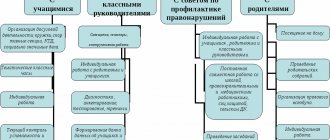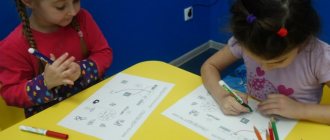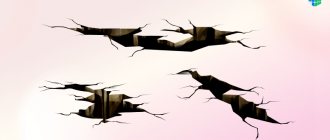Article:
Every society has certain standards of mental health, law, culture and morality. Social norms often suppress the instincts and desires of the individual. But if you want others to understand and accept you, you need to somehow meet these standards. For example, when you see a beautiful flower bed in bloom and follow social norms, you inhale the aroma and admire the flowers instead of picking them and taking them with you. Naturally, when raising your child, you try to accustom him to the same way of acting. And yet, even among respectable parents, the behavior of children sometimes goes beyond the norms prescribed by society. Psychologists call this behavior deviant, asocial, inadequate, and so on. What is the phenomenon of children with behavioral problems and how to deal with it?
Deviant behavior
In fact, children with behavioral problems are not that uncommon. Some deviations not only cause the indignation of parents and teachers, but also carry the seeds of future misconduct, posing a threat to the child himself, his environment and even society as a whole. Studying children with behavioral disorders, psychologists divide their actions into social deviations of self-interested, aggressive and social-passive orientation. Social deviations of selfish orientation include theft, fraud, speculation and other offenses, the purpose of which is to gain profit. Deviations of aggressive orientation are directed against the individual - these are insults, hooliganism, beatings, etc. Socially passive deviations are associated with a reluctance to solve personal and social problems, these include avoidance of school and work, vagrancy, drug addiction and suicide. Behind every external manifestation in children with behavioral problems there can be deep personal problems. And since there is no universal answer to all situations of deviant behavior, in order to help a child, you need to understand the reasons for each specific situation.
“Features of deviant behavior in adolescence” material
state budget professional
educational institution
"Magnitogorsk Construction and Installation College"
Report
On the topic: “Features of deviant behavior in adolescence”
Author-developer: Kovalchuk N.A.
master p./o GBPOU
2019
Content
1. Prerequisites and causes of deviant behavior of minors
. Social - psychological.
. Psychobiological
. Social
2. The influence of age characteristics on the formation of deviant behavior of minors
3. Features of behavioral reactions of deviant adolescents
Deviant behavior of adolescents is behavior that deviates from the norms and standards established by society, be it the norms of mental health, law, culture, morality, as well as actions that do not satisfy the social expectations of a given society in a specific period of time.
The prerequisites for deviant behavior of minors can be divided into several categories: Social - psychological, psychobiological, social.
1. Social and psychological prerequisites (families with destructive emotional-conflict relationships, pedagogical failure of parents or their low educational level.
2.Psychobiological prerequisites
Based on an analysis of numerous psychological, medical and pedagogical literature in adolescence, some crisis phenomena in the body: the psyche and relationships of adolescents can be attributed to the age-related psychobiological prerequisites for difficult education and deviant behavior of minors.
Firstly, this is the accelerated and uneven development of the adolescent’s body during puberty.
Secondly, these are changes in the nature of relationships with adults, expressed in increased conflict.
Thirdly, these are changes in the nature of relationships with peers, both with representatives of the same and the opposite sex.
In addition, the social adaptation of children and adolescents can be hampered by various neuropsychiatric diseases and abnormalities.
3. Social preconditions four large groups of social preconditions for deviant behavior can be distinguished.
-socio-economic prerequisites (low material standard of living, poor living conditions).
-medical - sanitary prerequisites (chronic diseases of parents, etc.) -
-socio-demographic prerequisites (single-parent or large families, families with elderly parents, families with remarriages).
- social and psychological prerequisites (families with destructive emotional-conflict relationships, pedagogical failure of parents).
The psychological reason for the deviant behavior of a difficult-to-educate teenager may be his inability to compensate for his inability to social environment in a socially acceptable way.
Difficulties in parenting are associated with insufficient development of a teenager’s general abilities. Such students do not sufficiently understand the requirements, find it difficult to respond to comments in a timely and adequate manner, and do not show proper intelligence when carrying out instructions and rules of behavior. Constant failure sharpens their negative attitude towards friends, teachers, parents, and forces them to look for “psychological substitutes” that compensate for the lack of positive emotions. In parallel with this, the development of educational difficulties occurs. Strengthening resistance to educational influences.
Violations in preschool education: this includes = violation of the requirements of the preschool education program, poor methodological training of individual teachers. This leads to the fact that their pupils find themselves difficult to teach and difficult to educate at school.
School for a child begins with a teacher, educator. The most advanced programs, textbooks, and technical teaching aids cannot compensate for the spiritual callousness, tactlessness, and psychological unpreparedness of the teacher.
As a negative fact, it should be noted that individual class teachers have unsatisfactory knowledge of the living conditions of a student prone to violations of discipline, the level of his intellectual and emotional-volitional development, interests, social circle, position in the family, in the class team. As a result, the school does not fully use the possibilities of an individual approach in working with difficult teenagers.
The difficulties of education should also be associated with the level of methodological support for the educational process.
Teachers and educators experience significant difficulties when it comes to determining the basic methods of educating and re-educating adolescents and clarifying the essence and specific purpose of each of them.
The reason for the emergence and growth of cases of difficult education and deviant behavior should be recognized as the gap between teaching and upbringing that sometimes occurs in the work of individual schools; the excessive enthusiasm of individual teachers for fashionable teaching systems and the introduction of new scientific innovations without making appropriate adjustments to the content and form of the educational process should be recognized as pedagogically unjustified in this regard.
Some teachers, however, are completely satisfied with the students’ performance, and therefore the offenses they commit are not noticed, remain unpunished, and corrections begin to develop into serious offenses and even offenses. In this case, the degree of inability to educate increases significantly; often the school is unable to cope on its own.
with absenteeism, pugnacity, hooligan antics and other deviations in the behavior of previously prosperous children.
The extracurricular activities of difficult teenagers are most often of an entertaining nature, and their interests in sports are unstable.
Difficult teenagers find it difficult to assert themselves, to gain positive status or leadership in the field of organized leisure, among peers who, as a rule, have more developed intelligence, stronger will and stable emotions.
The influence of age characteristics on the formation of deviant behavior of minors
“Our youth loves luxury, they are poorly educated, they mock their superiors and somewhat disrespect the elderly. Our current children have become tyrants, they do not stand up when an elderly person enters the room, they contradict their parents. Simply put, they are very bad."
Adolescence is often called a period of developmental imbalances.
This age is characterized by intense transformations in the entire mental sphere of a teenager. At this age, attention to oneself and one’s physical characteristics increases, the reaction to the opinions of others becomes more acute, self-esteem and resentment increase, and physical defects are often exaggerated.
Significant changes are taking place in the formation of intellectual activity. This age is especially characterized by the desire for knowledge, the formation of abstract thinking, and a creative approach to intellectual problems. Perception, memory, attention reach a level of high productivity and selectivity. Strong-willed traits acquire intensive development: perseverance, perseverance in achieving a goal, the ability to overcome obstacles and difficulties, the ability for purposeful volitional activity. Self-awareness and self-esteem are actively being formed, and there is an increased interest in how others evaluate their personal qualities.
Significant shifts in interests occur and spiritual needs develop. There is an intensive formation of moral beliefs and ideals, and moral feelings are developing.
In domestic pedagogy and psychology, one of the leading places is given to the problems of education and labor training of the younger generation.
Related tasks are most relevant for working with adolescent children. Raising a full-fledged member of society requires a set of measures that contribute to the correct formation of a teenager’s personality, the socialization of his interests, system of needs, and work attitudes.
In the implementation of these measures, a significant place belongs to the problem of the so-called difficult adolescents, in whom behavioral disorders or disturbances in the effective sphere become the cause of maladaptation.
The study of unfavorable social factors that play a leading role in the formation of behavioral difficulties in adolescents includes the study of the characteristics of the environment, upbringing and training that impede the process of proper formation of the adolescent’s personality.
The difficulties of adolescence were and still remain a serious pedagogical problem.
Its first objective basis is the significant differences between the requirements society places on children and adults, the differences in their responsibilities and rights.
The psychological characteristics of adolescence, when they are sharply expressed, are called puberty crisis.
The growing complexity of the social life of adolescents occurs during a period of rapid physiological restructuring of the body.
Changes in the activity of the endocrine system lead to pronounced fluctuations in autonomic functions. Adolescents under the influence of these physiological processes become emotionally unstable and vulnerable.
Especially often, somatic changes (such as fixed stuttering) occur with pronounced manifestations of acceleration. The phenomena of somatic acceleration are found at all ages, but they are especially noticeable during puberty.
Thus, the second objective basis for the complexity of adolescence is the extremely rapid pace of changes occurring during this period. We can say that teenagers and adults live on different time scales, and this is where all the differences in assessments of the same events or phenomena come from. At the same time, for an adult, much in a teenager’s behavior turns out to be unexpected and incomprehensible, especially since all this often turns out to be unexpected and incomprehensible for the teenager himself.
The third reason for the complexity of adolescence is related to the psychological changes that occur during puberty. Sexual interests play a significant role in the consciousness and behavior of a teenager.
There is increased attention to one's appearance.
It is during adolescence that gender acquires real social meaning for a person. During puberty, a teenager's self-perception changes. In addition, teenagers become the object of specific attention from some adults.
This creates its own problems.
The fourth objective basis for the complexity of adolescence is associated with the gradual awareness by adolescents of the differences in their position in the family. Each family has its own way of life, and the requirements for children in different families are not the same. As a result of the formation of public opinion in the classroom, which is relatively independent from the opinion of adults, adolescents begin to
be aware of the advantages and disadvantages of your position in the family.
The fifth objective basis for the complexity of adolescence is the accumulation of upbringing defects at this age, which previously were not clearly manifested due to the child’s lack of independence and the relatively narrow scope of his activity and communication. The teenager must increasingly act based on his inner motives, and his activities are assessed by those around him more strictly than the activities of the child.
2. Features of behavioral reactions of deviant adolescents
At the same time, the presence of childishness and adulthood traits appears in turn in psychological reactions typical of adolescence that arise during interaction with the environment.
Situational personal reactions manifest themselves in everyone during adolescence, but in pedagogically neglected adolescents they often develop into persistent antisocial manifestations. The main forms of situational personal reactions include: emancipation reactions,
“negative imitation”, grouping with peers, hobbies and reactions caused by emerging behavior, which are based on adolescents’ exaggerated desire for independence.
However, under unfavorable environmental conditions, such reactions lead to social disadaptation.
The reaction of “negative imitation” It manifests itself in behavior in contrast to the unfavorable behavior of family members and reflects the formation of an emancipation reaction, the struggle for independence.
The reaction of infatuation, it reflects the characteristics of the internal structure of a teenager’s personality and basically has a tendency towards highly valuable interests and hobbies.
Reactions caused by emerging sexual desires include premature initiation of sexual activity, etc.
It is necessary to distinguish between pathological and psychological situational personal reactions.
A psychological reaction is a transient, situationally determined change in a teenager’s behavior, which manifests itself only in a certain macrosocial environment, has a clear psychological orientation and does not lead to long-term disturbances in social adaptation.
Pathological situational reactions are manifested in stereotypical behavioral deviations that arise in various traumatic situations and tend to exceed a certain “ceiling” of behavioral disorders possible among peers. Such reactions most often develop gradually based on psychological reactions.
Depending on the nature, character and severity, pathogenic, psychosocial and social maladaptation of adolescents are distinguished.
Pathogenic maladaptation is caused by deviations, pathologies of mental development and neuropsychiatric diseases. which are based on functional-organic lesions of the central nervous system.
Psychosocial maladaptation is associated with the gender, age and individual psychological characteristics of a teenager.
Social adaptation is manifested in violation of moral and legal norms, in asocial forms of behavior and deformation of the system of internal regulation, value orientations and social attitudes.
The consequence of an incorrect approach to the education and re-education of pedagogically neglected students is social neglect. Socially neglected students not only study poorly, but also have chronic delays in the subjects of the curriculum and resist pedagogical influences, but they are also not professionally oriented, they have not developed useful skills and abilities, and their sphere of interests is narrowed. They are not characterized by deep alienation from family and educational institutions; their formation and social development is mainly under the influence of asocial, criminogenic teenage groups. Socially neglected adolescents are characterized by various serious social deviations: such as vagrancy, drug addiction, drunkenness, and immoral behavior.
Inappropriate child behavior
The child’s inappropriate behavior is based on negative affective experiences associated with the dissatisfaction of needs that are important to him. When an assessment of one's abilities, based on the child's previous achievements, does not correspond to the current situation and one must admit one's inadequacy, some children experience affective experiences. Instead of overestimating their aspirations, children show an inadequate reaction to failure - increased sensitivity, stubbornness, isolation, emotional instability, inhibition, denial. For example, if in one school a child was successful in English and received praise from the teacher, then when he enters another school, where his achievements do not stand out from other students, he may begin to resent the teacher and believe that he is being treated unfairly. Inappropriate behavior of a child is a kind of defensive reaction designed to help in the event of a fiasco. In order not to lower self-esteem, the child begins to blame parents, teachers, immediate surroundings, circumstances, fate. Inappropriate behavior of a child causes responses from teachers and parents, which in turn intensifies affective experiences. The circle closes.
Examples of deviant behavior and the correct reaction of parents
One of the common examples with which parents turn to a psychologist is when a child behaves aggressively for no apparent reason or makes scandals.
The most effective response on the part of adults, preventing the recurrence of such manifestations, will be its complete absence. Those. even if a child falls to the floor, chokes in hysterics and screams all over the street, the parent should start talking to him only after he has completely calmed down. Thus, self-control is trained and behavior is reinforced, in which the baby understands that he will be listened to only if he behaves normally.
Absenteeism from school and systematic failure to complete assignments should not cause an excessive reaction on the part of parents, but they also cannot be ignored. This form may be a way to attract attention from the family, or it may arise as a result of psychological difficulties that have arisen in the school community. Here it is important to calmly discuss with the child the reasons for this behavior, without interrogating or hinting at punishment. The main thing is to let the child understand that you are at the same time, that is, you are even ready to write a note to the class teacher if a banal rest will correct the situation.
In case of offenses and/or evidence of drug use, drastic measures are necessary to suppress this type of behavior, including changing the place of residence, if there are no other opportunities to change the child’s social circle. It is also necessary to carefully study the reasons for this behavior and eliminate them, since without removing the “root” of the problem, its recurrence is very likely.
Antisocial behavior of children
Speaking about antisocial behavior in children, psychologists note that it arises as a result of a violation of the interaction of the individual with the environment. Children with antisocial behavior are divided into four groups:
- First group. It includes children whose antisocial behavior is associated with deviations in the development of the emotional-volitional sphere and individual characteristics, up to psychopathy;
- Second group. These are children whose antisocial behavior is associated with incorrect forms of influence. For example, when adults impose strict disciplinary requirements on a child without taking into account his age, emotional state, or experiences. Children of this group do not need behavior correction; on the contrary, it is adults who must reconsider their attitude to their actions in the situation;
- Third group. It includes children with serious gaps in moral and ethical education. In other words, these are neglected children whose antisocial behavior is associated with the connivance of adults. Such children do not consciously violate social norms because they are simply not familiar with them;
- Fourth group. These are difficult-to-educate teenagers; the antisocial behavior of children in this group is associated with a distortion of moral ideas and personality traits. Such children understand that their behavior is contrary to social norms, but they do not want to change it and refuse any interference in their lives, reacting to critical feedback with indifference, defiant behavior and disagreeing with the negative assessment of others. This is the most difficult group to educate, since such children are confident that they are right.
Causes of the disease
The causes of deviant behavior in adolescents are divided into two large groups – social and physiological. The group of social reasons includes:
- single-parent families - in this case, a pattern of behavior with the opposite sex is not formed. In addition, one parent, while raising a child, often demands too much submission, obedience, and does not give the child attention and participation;
- errors in the educational process lead to conflicts with the teaching staff and teachers, as a result of poor performance;
- conflicting or asocial families - conflicts between parents lead to omissions in the educational process and the child’s detachment, and a parasitic lifestyle, antisocial behavior of parents or alcoholism generally become an example for action.
Among the physiological causes of deviant behavior in adolescents are the following:
- pathologies of the central nervous system are formed as a result of traumatic brain injuries or serious illnesses in the first years of a child’s life, and manifest themselves in instability of emotional expression and a decrease in the ability to adapt;
- features of adolescence - under the influence of a hormonal surge in the body, certain parts of the brain mature and a number of higher-type mental functions are formed, as a result of which the child experiences an exacerbation of character traits and the appearance of antisocial behavior;
- hereditary signs of mental deficiency, addiction to alcohol or drugs, abnormal character traits.
Suicidal behavior in children
In the most tragic cases, deviations in the child’s behavior take an extreme form - suicide. Psychologists believe that suicidal behavior in children is associated with an ambivalent attitude towards death - the child perceives death as a way of manipulation, for example, imagining how the mother will be upset, but does not realize the irreversibility of the consequences.
Typically, suicidal behavior in children is aimed at attracting attention; it is preceded by depression, boredom, loneliness, isolation, and aggression towards the environment. Sometimes suicidal behavior takes a hidden form when a child chooses extreme sports, joins dangerous groups, or takes drugs.
The reasons for suicidal behavior in children include conflicts with parents, peers, immediate environment, and misunderstanding at school. At the same time, children most often refuse the help of adults.
Integration into society
Typically, children with behavioral problems have difficulty making contact with teachers, psychologists, and adults, explaining this with the expression “they don’t understand me.” And indeed, in order to create a trusting relationship with such a child, you need to have a share of sympathy, interest in his life, hopes and worries, be able to listen patiently, give advice, empathize and move from free communication to guidance in a timely manner. Not every parent is capable of this, and certainly not every teacher. But this is the only way to reach children with behavioral disorders, form their understanding of universal human values, develop morally positive traits and character traits, and also help them adequately assess the picture of the world and be accepted into society.
Prevention of deviant behavior
Preventive measures should be aimed at identifying children at risk, eliminating factors contributing to the development of deviations, as well as providing timely assistance.
In order to stabilize the emotional and behavioral spheres in children and adolescents, it is necessary:
- To develop an interest in the world around us and people, a desire to study and understand the patterns of people’s reactions and the functioning of society. This needs to be done not only in educational institutions, but above all in the family.
- Introduce the child to the appropriate rules of behavior in various life situations. For kids, it is possible to consolidate the necessary skills in a playful way; for teenagers, training classes are suitable.
- Develop adequate self-perception and self-esteem, which subsequently makes it possible to navigate in any situation and choose appropriate behavior from those strategies that were successfully learned earlier.
- Develop communication skills in various forms for any situation, as well as with different categories of people. The more practice a person receives, the higher the likelihood of subconsciously using the correct strategy in a real situation.
- Parents should pay attention to intrafamily interaction and the psycho-emotional atmosphere in the family. Develop mutual understanding and parenting competence.
For categories of children and adolescents who have undergone correctional programs, it is necessary to prevent a return to previous forms of interaction. The key points here will be practicing the acquired skills and appropriate moral and psychological support.








